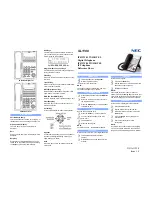
Reference
60
conflicting results. A few animal studies, however, have sug-
gested that low levels of RF could accelerate the development
of cancer in laboratory animals. In one study, mice genetically
altered to be predisposed to developing one type of cancer
developed more than twice as many such cancers when they
were exposed to RF energy compared to controls. There is
much uncertainty among scientists about whether results
obtained from animal studies apply to the use of mobile
phones. First, it is uncertain how to apply the results obtained
in rats and mice to humans. Second, many of the studies that
showed increased tumor development used animals that had
already been treated with cancer-causing chemicals, and other
studies exposed the animals to the RF virtually continuously--
up to 22 hours per day.
For the past five years in the United States, the mobile phone
industry has supported research into the safety of mobile
phones. This research has resulted in two findings in particular
that merit additional study:
1. In a hospital-based, case-control study, researchers looked
for an association between mobile phone use and either
glioma (a type of brain cancer) or acoustic neuroma (a
benign tumor of the nerve sheath). No statistically significant
association was found between mobile phone use and
acoustic neuroma. There was also no association between
mobile phone use and gliomas when all types of types of
gliomas were considered together. It should be noted that
the average length of mobile phone exposure in this study
was less than three years.
When 20 types of glioma were considered separately, however,
an association was found between mobile phone use and one
rare type of glioma, neuroepithelliomatous tumors. It is possi-
ble with multiple comparisons of the same sample that this
association occurred by chance. Moreover, the risk did not
increase with how often the mobile phone was used, or the
length of the calls. In fact, the risk actually decreased with
cumulative hours of mobile phone use. Most cancer causing
agents increase risk with increased exposure. An ongoing study
of brain cancers by the National Cancer Institute is expected to
bear on the accuracy and repeatability of these results.
2. Researchers conducted a large battery of laboratory tests to
assess the effects of exposure to mobile phone RF on genetic
material. These included tests for several kinds of abnormali-
ties, including mutations, chromosomal aberrations, DNA
strand breaks, and structural changes in the genetic material
of blood cells called lymphocytes. None of the tests showed
any effect of the RF except for the micronucleus assay,
which detects structural effects on the genetic material. The
cells in this assay showed changes after exposure to simulat-
ed cell phone radiation, but only after 24 hours of exposure.
9046K01-QUARK pgs 3/29/0 3:18 PM Page 23








































